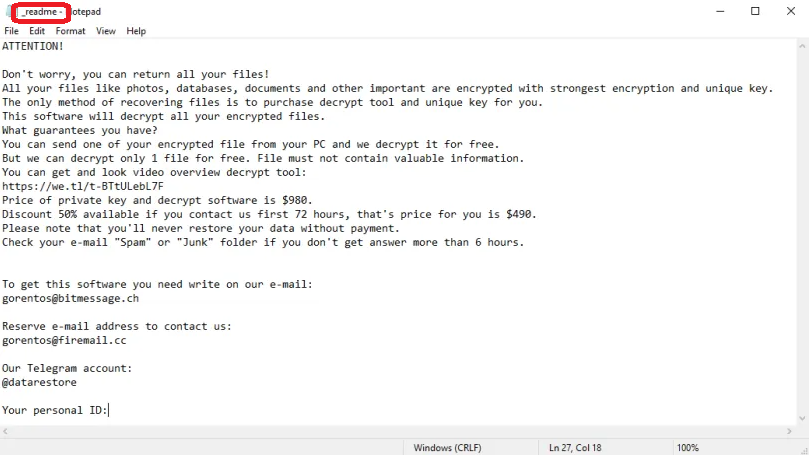.Sglh
.Sglh is a highly malicious Ransomware infection that seeks to extort money from its victims in the form of untraceable bitcoins. In order to blackmail them, .Sglh applies encryption to a list of commonly used files that are found in the computer and demands a ransom for them.

The danger you are faced with is also known as a cryptovirus and, on this page, we will help you understand how it operates and how you can remove it in the safest possible way. In the paragraphs that follow, you will find a useful removal manual for the deletion of .Sglh from and a professional removal tool which you can use to carefully scan your entire system. We will also share other methods that you can use to decrypt some of your encrypted documents and tips for preventing ransomware in the future.
The .Sglh virus
The .Sglh virus is a file-encrypting infection that asks ransom from its victims in order to liberate their files from a secretly applied encryption. After the attack, the .Sglh virus creates a ransom message and places it on the screen of the infected computer and in the directories with encrypted files.
In comparison to other online threats that could steal your data, destroy your software or hack the entire OS, Ransomware infections are unlikely to cause any major system damage or destroy your data. Instead, they will simply prevent you from accessing some of the files that are present on your computer or they will block the screen.
.Sglh, .Vvoa, .Agho in particular, are interested in encrypting your files and keeping them hostage until a ransom is paid for their decryption. This malware uses a very powerful encryption algorithm to make all of the documents on the affected computer unreadable. Only a special decryption key can reverse the encryption but that key is kept in secret by the hackers who are behind the ransomware. Normally, the hackers are ready to trade that key for a certain amount of money. That’s why they place a notification on the compromised computer and provide instructions and deadlines for the payment.
The .Sglh file encryption
The .Sglh file encryption is a complex algorithm of symbols which no software can recognize and read. The .Sglh file encryption code is only reversible with a special decryption key that is traded for a ransom.

Many online safety experts suggest that victims of Ransomware should always seek alternative methods to recover their data and avoiding the ransom payment at all costs. This is because the more victims decide to pay, the more online crooks will start using this type of internet money extorting as a quick way to make money. So, instead of giving your money to some anonymous cyber criminals, you can, for example, access our list of free decryptors or try to recover some of your records from system backups through our tips in the file-recovery section of the guide below. The most important thing is not to forget to remove .Sglh from the system before you try any file restoration methods because if you fail to do so, any new files that you restore or create may get encrypted again.
SUMMARY:
| Name | .Sglh |
| Type | Ransomware |
| Danger Level | High (Ransomware is by far the worst threat you can encounter) |
| Symptoms | Very few and unnoticeable ones before the ransom notification comes up. |
| Distribution Method | From fake ads and fake system requests to spam emails and contagious web pages. |
| Data Recovery Tool | Not Available |
| Detection Tool | [table_win_aside] |
Remove .Sglh Ransomware
![]()
Some of the steps will likely require you to exit the page. Bookmark it for later reference.
Reboot in Safe Mode (use this guide if you don’t know how to do it).
![]()
WARNING! READ CAREFULLY BEFORE PROCEEDING!
Press CTRL + SHIFT + ESC at the same time and go to the Processes Tab. Try to determine which processes are dangerous.

Right click on each of them and select Open File Location. Then scan the files with our free online virus scanner:

After you open their folder, end the processes that are infected, then delete their folders.
Note: If you are sure something is part of the infection – delete it, even if the scanner doesn’t flag it. No anti-virus program can detect all infections.
![]()
Hold the Start Key and R – copy + paste the following and click OK:
notepad %windir%/system32/Drivers/etc/hosts
A new file will open. If you are hacked, there will be a bunch of other IPs connected to you at the bottom. Look at the image below:

If there are suspicious IPs below “Localhost” – write to us in the comments.
Type msconfig in the search field and hit enter. A window will pop-up:

Go in Startup —> Uncheck entries that have “Unknown” as Manufacturer.
- Please note that ransomware may even include a fake Manufacturer name to its process. Make sure you check out every process here is legitimate.
![]()
Type Regedit in the windows search field and press Enter. Once inside, press CTRL and F together and type the virus’s Name.
Search for the ransomware in your registries and delete the entries. Be extremely careful – you can damage your system if you delete entries not related to the ransomware.
Type each of the following in the Windows Search Field:
- %AppData%
- %LocalAppData%
- %ProgramData%
- %WinDir%
- %Temp%
Delete everything in Temp. The rest just check out for anything recently added. Remember to leave us a comment if you run into any trouble!
![]()
How to Decrypt .Sglh files
We have a comprehensive (and daily updated) guide on how to decrypt your files. Check it out here.
If the guide doesn’t help, download the anti-virus program we recommended or try our free online virus scanner. Also, you can always ask us in the comments for help!

Leave a Reply